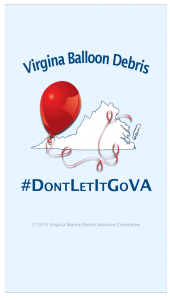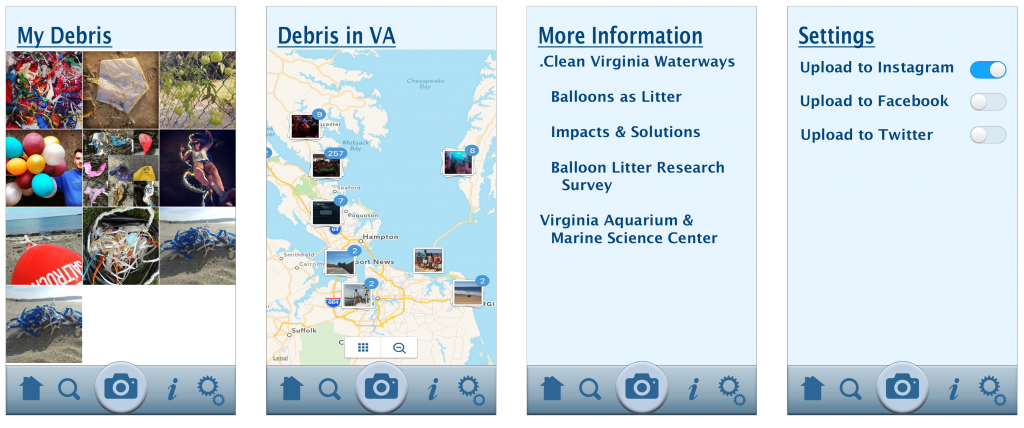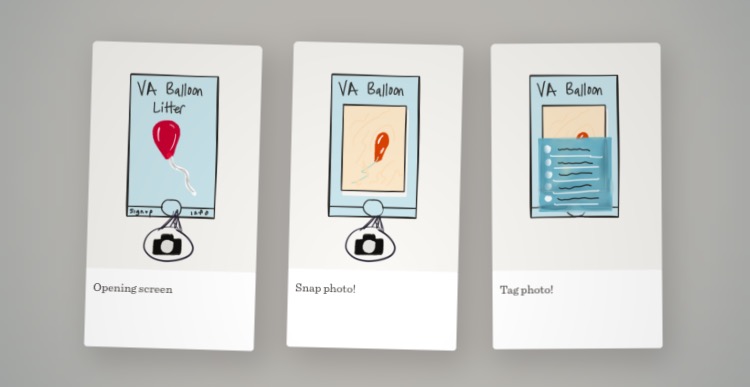Following the December meeting, I made changes to my game that made it simpler and closer to my research. I created two models, one of sand and one of seagrass. For the seagrass, I used green ribbon, as this is what my lab uses as artificial seagrass in field and lab experiments. For crabs, I currently have blue marbles, although I am still debating if they are the right size (and if I should draw crabs on them). If I do change materials, I would pick something smaller. My second option is to make a thicker “seagrass” habitat. During the symposium, I’ll use these as models of the different habitats available to juvenile blue crabs. I’m still toying with a few different ideas for the game itself. Below is an in-progress image of the models. There are a few finishing touches left to add, so more pictures to follow.
Category Archives: Apps/Games
Final-ish product! #DontLetItGoVA App
Still working on the backend!
Edit: Don’t know why it’s blurry! Sorry about that!
First Draft – VA Balloon Debris #DontLetItGoVA
I have been working on the visuals and general layout of the balloon debris app, with the goal of making a more usable version of the Virginia Balloon Study web form. The app can be promoted via social media to students, concerned citizens, and clean-up volunteers, and the information gathered will be of use to a variety of stake-holders, including Clean Virginia Waterways (CVW), Virginia’s Coastal Zone Management Program (CZMP) and the Virginia Marine Debris Advisory Committee. I will be sending this draft to the above stake-holders and making adjustments based on feedback.
I plan to have a working demo-version of this app to present at the SeaGrant Symposium in January.
Overview of App
Splash Screen
The Splash Screen is the screen that will be displayed when the app is launched on the device.

Splash screen showing the name of the app (Virginia Balloon Debris), logo, and hashtag #DontLetItGoVA
Tips
The series of images below shows the first launch tips screen, with each tip popping up successively as the user taps through.
Standard View
This is what the user will see first every time the app is launched.
The information gathered regarding Material, Burst/Deflated, Attachments, Type of String, Animal Entangled, and Comments can be collected in a database, such as the one already in use by Clean Virginia Waterways and the Virginia Aquarium.

Once the user snaps a photo, the app will automatically display pop-up selections with radio buttons so that adequate information is gathered regarding the image.
Other Screens – Home, Search, Info and Settings

The Home button brings up a view of all images the user has taken. Search shows a pin-in-map view of other debris reports from around the state. Information displays links that the user can navigate to in order to learn more (launches in browser). Settings allows the user to automatically post the images taken to favorite social media, with the hashtags #DontLetItGoVA and #BalloonDebris.
Project Proposal: Life among the Oysters
Oyster reefs provide a suite of valuable ecosystem services, such as water filtration, nitrogen sequestration, and provision of habitat and foraging grounds for benthic organisms. Unfortunately, these habitats have suffered significant global decline over the last century. This global decline has had negative economic and ecological impacts in coastal waters worldwide. This problem is quite severe here in the Chesapeake Bay where < 1% of the historic oyster population remains. As a result there are increasing efforts to restore oyster populations and the services they provide. Building reefs that successfully provide specific ecosystem services – such as provision of benthic habitat – may require different techniques then previously used, and success may depend on reef morphology, location, and environmental conditions. Additionally, there remains limited understanding and information regarding the value of restored oyster reefs as an important habitat in the Bay, and the factors that influence this value. My research seeks to first quantify the organism abundance and composition on restored oyster reefs, and then relate it to the location (environmental parameters) and structural complexity of the reefs. To this end settling trays were embedded into previously restored oyster reefs that varied in their structural complexity (rugosity), as determined by the chain-link method. Trays were collected after 7-weeks, sorted, and species identified and weighed (ash-free dry weight) to obtain species diversity, abundance, and biomass.
There are many different stakeholders interested in the issue, but the one I will focus on is the general public. More specifically I will target those members of the local community who are seeking to become more knowledgeable about and engaged in the research being conducted here in the Bay, right in their backyards. From my conversation with people in the local community they seem really interested in understanding the Bay and research being conducted here, but may have trouble finding the information they are looking for, or finding ways to gain knowledge in an easy to understand manner. Particularly with oyster reef restoration I’ve realized that most people don’t think of oyster reefs as an important habitat, and don’t know much about the numerous species that live on these reefs. Most people tend to think of the oyster and its economic values.
For my communication outreach project I want to provide an easily accessible and understandable means for this target audience to satisfy their desire to learn about and participate in Chesapeake Bay research. In particular I want to highlight the role of oyster reefs as an important habitat in the Bay and highlight the various organism that are found in high abundance on these reefs and rely on these reefs for survival. In order to accomplish this I will design a website where I provide a background of oysters and restoration efforts in the Bay, and then describe the research I am conducting. In order to help explain my methods and engage the audience I want to incorporate some sort of interactive component on the webpage. For instance, I was thinking of having a ‘sorting game’ where there are pictures of worms, fish, crabs, shrimp and mussels all mixed up in a square area, and they have to sort them by picking them out and placing them the appropriate species box. Another option would be to have then take some rugosity measurements. My hope is that this website will provide a forum for my research to become assessable to the public, and allow them to gain a better understanding and appreciation of the importance of restored oyster reefs to the health of the Bay. I believe that having an informed and engaged public will help put more pressure on managers, and increase support for more restoration efforts in the Bay.
A Multi-Faceted Approach to Teleost Biodiversity Education
Climate change has been increasingly identified as a strong driver in shifting species distribution and promoting extinction. Marine species track very close to climate changes and are especially at risk due to rising sea temperatures coupled with anthropogenic factors such as over-fishing and pollution. In the near future, commercially important teleost species may be lost due to climate change pressures. Losses of teleost biodiversity will could have significant economic and societal impacts on the state’s economy and the communities that rely on these species. The goal of my master’s thesis will be examine forecast changes in biodiversity of Chesapeake Bay teleosts by not only examining taxonomic diversity, but by taking into account phylogenetic and functional diversity as well. By considering multiple aspects of biodiversity, I hope to aid in the development of novel conservation strategies and diagnostic tools that will aid in the preservation of valuable Chesapeake Bay fish species.
The long term goal of this project is to help ensure teleost biodiversity remains present for future generations. However, fisheries and local communities often view conservation initiatives as a callous limitation of their livelihood. I believe that this ultimately arises due to a failure to understand the long term objectives of biodiversity conservation and the importance of biodiversity to ecosystem function. In order to gain support for my research, I wish to adopt a multi-faceted educational approach. On the surface, biodiversity is a fairly easy concept to understand, but it is likely that the majority of the public has little experience with phylogenetic or functional diversity. My outreach will focus on educating the community as why these two facets are important as well as why maintaining teleost as a whole is critical to ecosystem health and coastal economies.
I intend to take a multi-faceted approach in order to educate the public on phylogenetic diversity, functional diversity, and the effects that climate change has on these two biodiversity indices. Working with Kattie McMillan, I will volunteer with the VIMS Communications Office by giving VIMS campus tours, participating in local festivals attended by the VIMS Office of Communication, and by giving talks with Science Under Sail during trawl voyages. This will allow me to convey my research to members of the public that are already interested in learning more about the ecological and biological dynamics of the Chesapeake Bay as well as the threats it faces. Hopefully, these receptive members of the community will help to entice their less enthusiastic neighbors into learning more about biodiversity and conservation as well. In general, these efforts will consist of me speaking about biodiversity and discussing my research, but I also intend to develop an interactive activity for Marine Science Day in order to help foster interest in marine biodiversity among children. Kids and their parents will have the opportunity to bring stuffed animals from home which I will use to create a quick phylogeny and dendogram. I believe that people naturally curious about the evolutionary relationships between organisms and that this will enable them to understand the methods used in creating biodiversity indices in an entertaining manner.
I will also use an online approach to help engage the public. In order to quantify phylogenetic and functional diversity, I will have to create a phylogeny and dendogram. My hope is to make both available online either as part of a blog, website, or Facebook page. Interested individuals will be able learn about the phylogenetic and functional relationships between Chesapeake teleosts at their own pace. I also wish to make the phylogeny interactive, if possible. If a user clicks on a specific fish in the phylogenetic tree, the branches leading to that individual could change a different color so that the user could more easily visualize its relationship to other taxa. A brief description of the fish would also appear in the text box.
I feel that a combination of personal and technological educational methods would present the public with ample opportunities to deepen their understanding of Chesapeake Bay teleost diversity and the potential threats that global warming may present to the ecological community. By increasing the public’s awareness of the importance of fish biodiversity, I could help to generate and improve support for marine conservation research. Hopefully, more support from the community will eventually lead to more support from lawmakers as well.
Product Proposal – An App for That
Marine debris is an issue of local, national, and global concern, impacting all oceans and waterways. The National Oceanic and Atmospheric Administration (NOAA) defines marine debris as any persistent solid material that is manufactured or processed and directly or indirectly, intentionally or unintentionally, disposed or abandoned into the marine environment or the Great Lakes. This broad definition encompasses everythingfrom derelict fishing gear to microplastics. The Commonwealth of Virginia developed a Marine Debris Reduction Plan (MDRP) in 2014 in order to address this problem through Virginia policies and programs. It is estimated that 49% of all marine debris in the U.S. comes from land-based sources, with 18% coming from ocean-based sources and the remaining 33% made up of items that could come from land or ocean-based sources (Sheavly, 2007). Marine life can easily mistake plastic bags, balloons, and other debris as a food source or ingest it accidentally during normal feeding. These items can become lodged in the throat or digestive track and damage the gut, resulting in malnutrition or death. Entanglement in marine debris is also a serious hazard.
My Master’s thesis research addresses microplastic pollution and the sorption of persistent, bioaccumulative, and toxic organic contaminants (PBTs) often found in marine waters. Specifically, I am investigating how bio-based, biodegradable plastics compare to traditional plastics in terms of sorption of PBTs. Microplastics are defined as pieces of plastics that are <5mm in size, and are either intentionally manufactured or are the result of the breakdown of larger plastic debris. Their small size corresponds to an increase in surface area, which allows for the enhanced sorption of chemical contaminants. Various organisms, including zooplankton (Cole, 2013) and oysters (van Cauwenberghe, 2014) can then ingest these contaminated microplastics, potentially leading to the bioaccumulation and biomagnification of these chemicals. With consumers beginning to demand eco-friendly, “green” alternatives to traditional plastics, bio-based plastic market share is sure to increase (Technavio, 2014), leading to an increase in bio-plastic marine debris. Waste and coastal resource managers can then use the information supplied by my research in order to understand the potential effects of marine microplastic debris on the ecosystem.
Balloon litter has been identified by participants in the 2013 Virginia Marine Debris Summit to be of particular concern in Virginia, and also identified as “most achievable” in terms of systematic waste reduction by various stakeholders (Register, 2014). The Virginia MDRP designated development and implementation of a social marketing campaign addressing balloons as marine debris items as a part of its first set of near-term goals to be achieved by 2016. Though not an explicit part of my thesis research, my interests in marine debris as a whole has lead me to investigate this issue more closely, and that is why I am proposing to develop a smartphone application that uses citizen science data to collect information about balloon litter in Virginia, and to educate users on the impacts of balloon releases.
The product I aim to develop will be a prototype for an Apple iOS application that allows the citizen scientist to document instances of balloon litter in Virginia. Ideally, the app would allow the user to take a photo of the debris and allow for quick-select tagging of various options, including an entangled or dead animal. Location and debris information could then be uploaded and stored in a database that can then be queried for “hotspots” and filtered by location or tag. Users would also have the option to publish their photo to popular social media outlets such as Instagram, Twitter, and Facebook with automated hashtags to identify the app and purpose (i.e. #VAballoons, #VAmarinedebris, etc.). Other features of the app would include a “map view” of documented debris, information on what happens to balloons when they are released, and a page of links to more information.

Clean Virginia Waterways (CVW), Virginia’s Coastal Zone Management Program (CZMP) and the Virginia Marine Debris Advisory Committee would be the stakeholders most interested in this outreach product and my ongoing thesis research. Katie Register of CVW has expressed explicit interest in this product, and I will be working with her, Christina Trapani of EcoManiac, and Laura McKay and Virginia Witmer of CZMP to develop this application.
The benefits of this product are that it can be used as a data-gathering tool and as an educational tool for social marketing and social change. Measurable outcomes outlined in the Virginia MDRP include commitments from targeted audiences to stop mass balloon releases and a measurable reduction in balloon litter in Virginia. Balloons are unique in that people often purchase them with the intent of releasing them into the environment, as a part of a ceremony or tradition. This app can directly contribute to both of these outcomes through the interconnectedness of social media, it is possible that images and information shared by users can help to educate the general public about the hazards of balloon releases. This app can also collect data regarding balloon debris not quantified by volunteer cleanup events, contributing to the overall understanding of the issue.
Literature Cited
Cole, M.; Lindeque, P.; Fileman, E.; Halsband, C.; Goodhead, R.; Moger, J.; Galloway, T. S. Microplastic Ingestion by Zooplankton. Environ. Sci. Technol. 2013, 47, 6646-6655.
Register, K. Virginia Marine Reduction Plan. Prepared for Virginia Coastal Zone Management Program by Clean Virginia Waterways, Grant Number NA11NOS4190122 and Grant Number NA12NOS4190168. 2014.
Sheavly, S. National Marine Debris Monitoring Program: final program report, data analysis and summary. Prepared for U.S. Environmental Protection Agency by Ocean Conservancy, Grant Number X83053401-02. 2007.
Technavio. Global Biobased Polymers Market 2015-2019. 2014.
Van Cauwenberghe, L.; Janssen, C. R. Microplastics in bivalves cultured for human consumption. Environ. Pollut. 2014, 193, 65-70.



